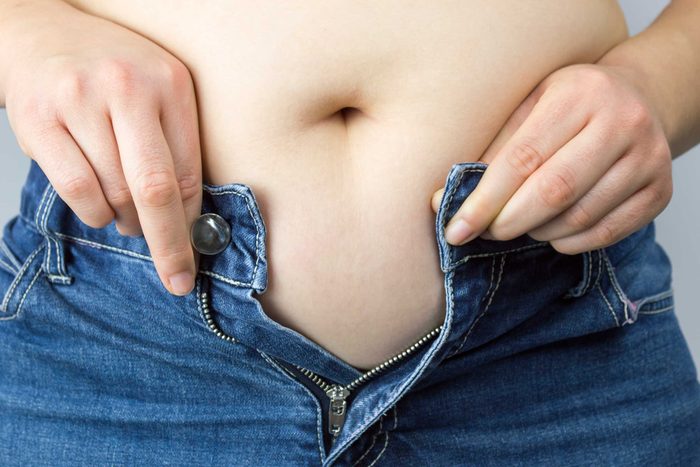
Abdominal cramping
Abdominal cramping is perhaps one of the most common symptoms of ovulation. “For some women, there are telltale signs like sharp cramping on one side of the abdomen, but for others, there are no signs at all,” says Jennifer Conti, MD, obstetrician-gynecologist at Stanford University and private practice in Palo Alto, CA. “This is why getting pregnant or trying not to get pregnant can be challenging using just a calendar, especially if your periods are not like clockwork every month.” The mild cramping usually happens in the lower abdominal area, typically on one side of the pelvis, on the same side from which you release an egg, according to Fahimeh Sasan, DO, assistant professor of obstetrics, gynecology, and reproductive science at the Icahn School of Medicine at Mount Sinai. “This pain is called ‘mittelschmerz,’ a German word meaning ‘middle’ and ‘pain’,” Dr. Sasan says, and it occurs mid-month for many women. If you have severe cramps, along with painful periods, talk to your doctor to rule out uterine fibroids or endometriosis.

Breast tenderness
Both breast pain and nipple soreness, regarded as secondary symptoms of ovulation, are direct results of the body preparing itself for pregnancy, explains Dr. Conti. The reproductive hormone progesterone prompts the breasts to begin retaining fluid, causing them to stretch out slightly. This often leads to soreness, tenderness, or particularly dense or heavy feeling breasts, typically in the days to week before your period. While common among many women, breast tenderness isn’t the best way to determine if you are ovulating, as it can also be symptomatic of PMS or pregnancy. And even though it is a sign you ovulated that month, it doesn’t typically correlate with the time of ovulation. That means it’s more useful in retrospect, not as a sign of current ovulation. You should still keep track of the symptoms.

Bloating
If it’s a struggle to button your pants around this time of the month, you can blame the same hormone responsible for breast tenderness. A rise in progesterone levels not only causes the breasts to begin retaining water but the rest of the body as well, says Dr. Sasan. This fluid retention often results in an uncomfortable bloated feeling, especially in the abdominal area. If bloating is a problem for you, you can help reduce bloating symptoms by limiting your caffeine intake and moving larger meals to the earlier part of the day when the digestive system is more active. Eating these foods can help relieve bloating.

Shifts in body temperature
Your temperature won’t change so dramatically that you’ll need to throw on a sweater or start shedding layers, but if you’re tracking your body temperature throughout your cycle for purposes of getting pregnant, you will see a subtle shift, says Dr. Conti. Most women display a measurable dip in body temperature just before ovulation, followed by a slight rise immediately after. Tracking your temperature first thing in the morning every day (before you even get out of bed) can be a good way to determine whether ovulation has occurred. Just be aware that several conditions can affect the accuracy of readings on the thermometer, such as fever or restless sleep.

Increase in libido
Ever experience a surge in your sex drive at a certain time of the month? It could be one of the major symptoms of ovulation. This is nature’s way of getting those reproductive wheels in motion, triggering your body to get busy in the bedroom. In fact, a study in the journal Human Reproduction found a 24 percent increase in sexual activity during the most fertile few days of a woman’s monthly cycle. This increase in libido can be attributed to a rise in estrogen and testosterone. If you’re looking to get pregnant, your body is on board with that mission around this time of the month, which is why it’s best to track your cycle, keeping these key dates and ovulation symptoms in mind.

Light spotting
Mid-month spotting can be one of many symptoms of ovulation as well, advises Dr. Conti. During a woman’s cycle, two hormones run the show—estrogen during the early half, and progesterone during the latter half. As your cycle progresses, progesterone works to build a thick wall that lines the uterus and is then released during menstruation if a fertilized egg hasn’t been implanted. Some women experience small spots of pink or brownish blood during ovulation because the production of progesterone is not quite high enough to keep the lining intact (it would be if you were pregnant). If you’re spotting more frequently, see your doc to rule out health conditions such as PCOS and thyroid problems.

Change in vaginal discharge
This key symptom of ovulation happens to all women whether you notice it or not, as the body thins its typically thicker vaginal fluids in preparing for possible conception. By thinning your discharge, your body is creating ideal conditions for the sperm to travel and meet a released egg easily and efficiently, says Dr. Sasan. Women can usually tell that ovulation is coming when the vagina secretes a slick or slippery fluid of a clear consistency, usually resembling a raw egg white. Most often, the body will produce the highest amount of this fluid on the exact day of ovulation, which is why keeping tabs on the habits of your body can come in handy if you’re trying to conceive. Here’s what else your vaginal discharge reveals about your health.

A heightened sense of smell
This one definitely registers on the “weird symptoms” end of the spectrum, and one that most women probably aren’t well aware of, at least not consciously. Science can’t really explain it, but one 2013 study found that certain women’s sense of smell sharpened, rendering them particularly sensitive to the scent of musk and male pheromones around the luteal phase of their cycle, immediately following ovulation. In terms of tried and true symptoms of ovulation, this one probably isn’t too reliable, but a fun fact to keep in mind nevertheless!

A change in your cervix
Some ovulation symptoms may be virtually imperceptible, but this is one you will notice if you’re keeping tabs on the positioning of your cervix—that passage connecting your vagina and your uterus, throughout the month, says Dr. Conti. Usually resting low in the body with its opening tight and closed, the cervix will actually shift slightly to allow sperm to travel more easily. You can measure your cervix by inserting two fingers into your vagina and noticing what you feel throughout the month. As ovulation approaches, you may be able to witness a softening or slight opening of the area—a literal opening of the door to any incoming sperm. And make sure you know the early signs of pregnancy, as well.